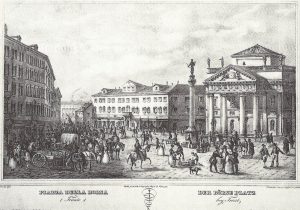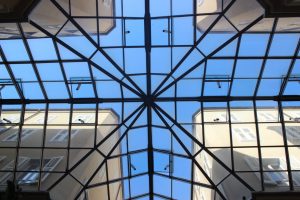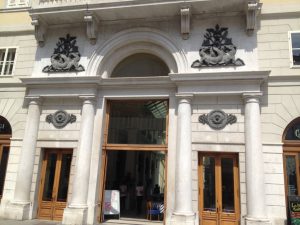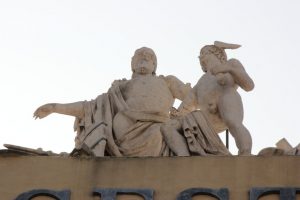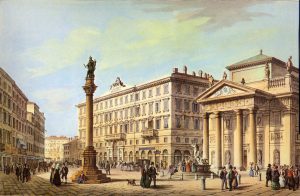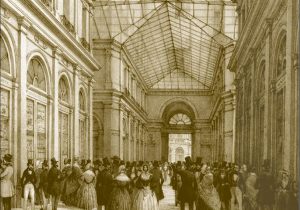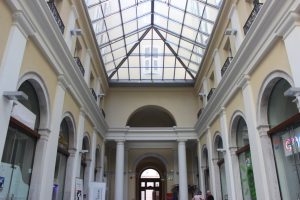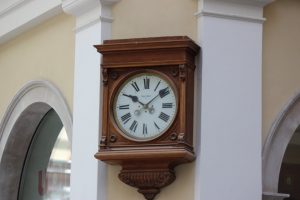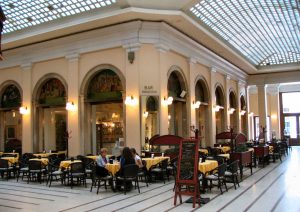Il Palazzo Tergesteo è a pochi passi da Piazza Borsa e Piazza Unità.Il Palazzo Tergesteo fu edificato sul sito della Dogana Vecchia su iniziativa di un gruppo di azionisti, la “Società del Tergesteo”.
Fu costruito in soli due anni su progetto dell’architetto Francesco Bruyne e inaugurato la sera del 24 agosto del 1842. Costò circa due milioni di lire austriache e fu uno degli ultimi palazzi di Trieste realizzato in stile neoclassico. La costruzione si sviluppa su quattro piani fuori terra oltre al piano terra e all’ammezzato ed è costituita da quattro corpi di fabbrica separati da una galleria, posta al piano terra,
la forma di croce greca e ispirata alla Galleria de Cristoforis di Milano, coperta da spioventi con l’intelaiatura metallica.
Gli accessi al fabbricato sono ubicati sui quattro lati dell’edificio: quattro sono gli ingressi alla galleria, due posti specularmente uno principale su Piazza della Borsa, ed uno su piazza Verdi, e altri due su via del Teatro e via Einaudi.
I due gruppi scultorei marmorei che sovrastano le facciate principali furono aggiunti successivamente. Quello sulla facciata verso piazza della Borsa, opera di Pietro Zandomeneghi, raffigura la dea del mare Tetide, in piedi su di una conchiglia trainata da quattro cavalli e con in braccio un bimbetto e a destra Mercurio,dio del commercio. La scultura rappresenta la città di Trieste trainata dalle fortune che provengono dal mare, ma anche dal commercio e dalla nascente industria.
Il secondo gruppo scultoreo sulla facciata posteriore verso il Teatro Verdi, opera di Antonio Bianchi, rappresenta Nettuno e Mercurio con le allegorie della geografia e della storia.
Il palazzo fu sede della Borsa triestina dal 1844 al 1928 e del Lloyd Austriaco dal 1857 al 1883 e divenne il luogo più rappresentativo di commercio e di ritrovo della Trieste ottocentesca.
Molti personaggi famosi frequentarono il Tergesteo tra i quali lo scrittore triestino Italo Svevo, che utilizzò la galleria come sfondo per il suo romanzo, “la Coscienza di Zeno”.
Durante la seconda guerra mondiale e gli anni dell’occupazione il Palazzo subì numerosi danni e nel 1957 l’architetto Alessandro Psacaropulo intervenne sulla galleria, sostituendo la copertura originaria a spioventi con una struttura in vetro-cemento. Nel 2009 un’attenta opera di restauro ha riportato il Palazzo Tergesteo agli splendori dell’epoca Asburgica e il cuore dell’intervento è stata la ricomposizione della Galleria nella sua versione ottocentesca originale.
All’interno della Galleria un orologio a parete originale, non funzionante, segna l’ora e il giorno in cui fu firmato l’atto costitutivo della Società per Azioni Tergesteo e dal 1863.
Verso Piazza Verdi c’era il Caffè Tergesteo uno dei caffè storici di Trieste, caratterizzato dalle vetrate colorate che raffiguravano episodi della storia triestina, luogo di ritrovo dell’elite culturale dell’epoca e molto frequentato anche dal poeta triestino Umberto Saba.
“Caffè Tergesteo… tu concili l’italo e lo slavo, a tarda notte, lungo il tuo bigliardo“.


